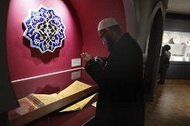In the heart of the largest concentration of Muslims in the U.S., the Detroit Institute of Arts this weekend is opening a new permanent gallery of Islamic art showcasing exhibits including a rare 15th-century Quran of a Mongol conqueror.
"The Arab and Islamic community is significant enough that it needs to see itself in the museum," said director Graham W.J. Beal. "Their collection had not been shown very prominently in the previous recent decades."
In Detroit, the gallery of about 170 works of art from the Mediterranean region, the Middle East, Central Asia and India was several years in the making. It was to be part of the museum's $158 million makeover completed in 2007 but required extra time and money.
The gallery, with its pointed arches, narrow columns and soft lighting, give the collection a solemn yet inviting feel. Themes spanning 1,500 years include "Silk Road Inspirations," whose works reveal the reach of the Islamic world and its role linking East and West; and "Sacred Writings of the Islamic World," that includes Christian and Jewish manuscripts from the Islamic world.
Among the gallery's treasures: one of the largest-known Ottoman mosque candlesticks from about 1500; an elevated giant cut-velvet summer floor covering made between 1650 and 1700 in Turkey, believed to be the largest of its kind; and a 15th-century leather-bound Quran, whose gold-flecked paper was given by the Ming emperor of China to Timur, one of the Mongol conquerors of the Middle East.
Heather Ecker, the museum's Islamic art curator, described it as the "most spectacular and important piece in the collection" and said it's one of four surviving manuscripts and the only one in the U.S.
The gallery's completion follows an ambitious, in-house archaeology project. A cut-tile mosaic panel hanging above the Quran dating back to 15th century Iran was found in storage, and the mosque candlestick also was stored, covered in green wax and misdated to the 18th century. Both have been at the museum since the 1920s.
Ecker says interest in Islamic art has risen since the Sept. 11 terrorist attacks. Before then, it was largely kept on the sidelines or in a supporting role to European and American art.
"I think there's a wish to understand and I think much more energy is being dedicated to understanding what the Islamic world is, its languages, its cultures and its people," she said.
Beal said a new generation of museum directors are pushing to abandon geographical or cultural hierarchies and develop collections that "connect with people."
Ecker said it's impossible to separate the museum's work from those outside tensions, but it can help dispel ignorance.
"When a museum has a collection as we do, we do feel a responsibility to provide not only a beautiful experience ... but also an educational experience, because I think there's a lot of ignorance," she said. "Not only among non-Muslims, but a lot of Muslims don't have a good understanding of the 1,500 years of Islamic history."
By usatoday.com
Related Links:
Berlin museum of Islamic art aims to end prejudice
London Shows Islam Science Contributions



